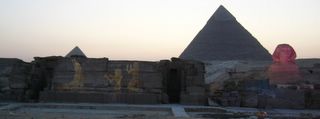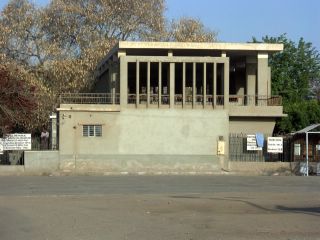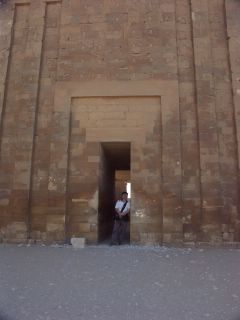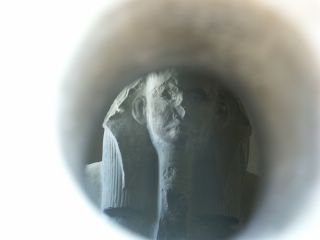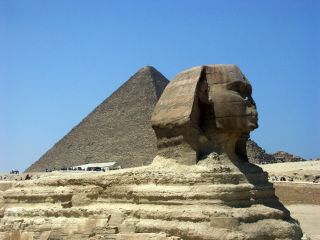The Great Pyramid of Giza is the last surviving member of the Seven Wonders of the World. There are in fact three main pyramids in Giza; the Great Pyramid of Khufu (or Cheops), The Pyramid of Khafre (or Chephren) and the smaller Pyramid of Menkaura (or Mycerinus). Each Pyramid is a tomb to a different King of Egypt.
Trivia: Only the Great Pyramid of Khufu, not all three Great Pyramids, is on top of the list of Wonders.
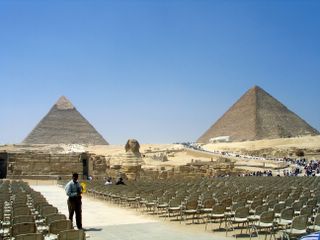
The Pyramids of Giza - Right is Pyramid of Khufu and left is Pyramid of Khafre
Giza is located only a few kilometers south of Cairo, several hundred meters from the last houses in the southernmost part of the city proper, where a limestone cliff rises abruptly from the other side of a sandy desert plateau. The ancient Egyptians called this place imentet, "The West" or kher neter, "the necropolis".
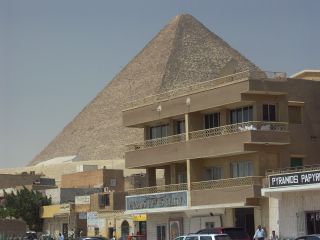
Village so close to the Pyramids
To enter into Pyramids area, admission fee of EGP 20 (EGP 10 with ISIC) is applicable. Inside, to enter into each monuments will cost additional admission tickets again! The Pyramid of Khufu costed us EGP 50 each, and that's with ISIC card. Without discount it's EGP 100, a steep increase from EGP 40 previously, very expensive! I don't think it's worth the price, as there is nothing inside! Just an empty chamber. When I entered to the Pyramid, a woman sang some ghostly song, it's scary if I'm alone, but did provide some entertainment after a hard climb inside the pyramid.

Camel walked past Great Pyramid of Khufu
Pyramid of Khufu - The Great PyramidKhufu (2589-2566 BC) was the builder of the Great Pyramid at Giza. In ancient times, this pyramid was known as "Khufu is the one belonging to the horizon". His father Sneferu, had in fact built the first ever true pyramid, the "north" or Red Pyramid at Dahshur, near Saqqara.
Like all pyramids, Khufu's was part of a complex, of which the three small pyramids known as "pyramids of the queens" are the most obvious part. There is a ruined temple on the east side, and the causeway leading out to the valley temple has been lost beneath the modern settlement of Nazlet el-Simman. Several boat pits surround the pyramid, and boats have been found in two of these. Khufu's pyramid is unusual because the burial chambers are built within the structure, as opposed to the more usually underground chambers found in most pyramids.
Originally the pyramid would have been covered by a layer of smooth white limestone and possibly crowned by gold sheet at the apex. This covering was stripped away in medieval times, but some still remains on the apex of the neighbouring pyramid of Khafre.
Pyramid of KhafreKhafre (2558-2532 BC) was the builder of the next great pyramid at Giza. The site of this pyramid is on a slight eminence and retains some of its limestone casing at the apex, and it therefore actually appears larger than that of Khufu, and is often mistaken as the Great Pyramid. In ancient times this pyramid was known as "Great is Khafre", and is more typical of Old Kingdom pyramid design in having an underground burial chamber. The Great Sphinx is carved from an outcrop of rock in a quarry beside the causeway to Khafre's pyramid, and this famous sculpture is usually assigned to Khafre's reign.
Pyramid of MenkaureMenkaure (2532-2503 BC) has the smallest of the three pyramid complexes at Giza. His valley temple was not of granite but finished of mud brick instead. Menkaure's pyramid had its burial chambers below ground, just like that of Khafre, but unlike the others the interior walls were carved. In ancient times this pyramid was known as "Menkaure is Divine".




